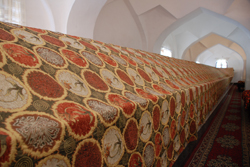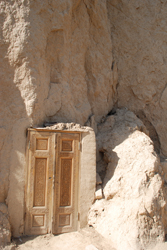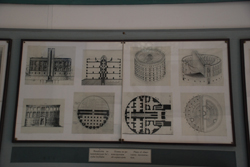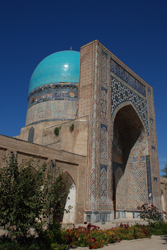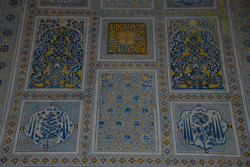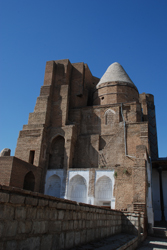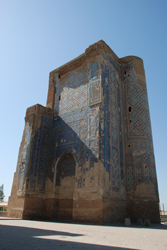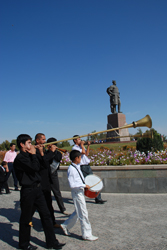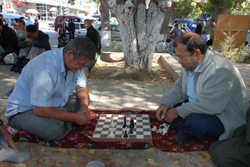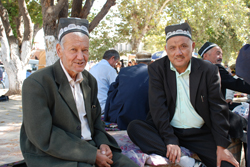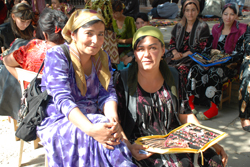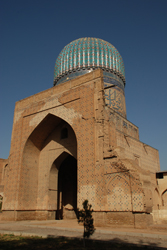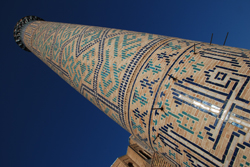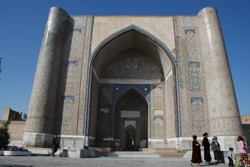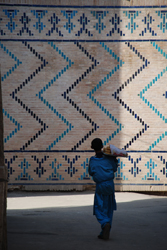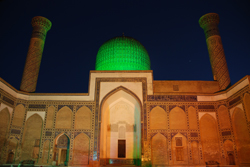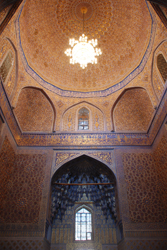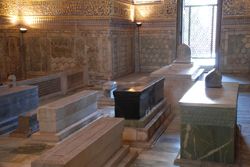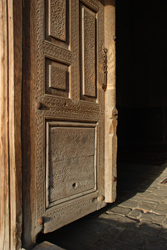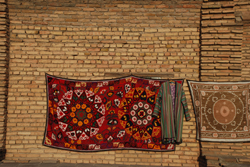Samarkand: I Like Ulugbek
9 October, 2008, 03:16 am in "Uzbekistan"
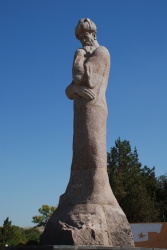 The Tomb of Daniel is considered to be a holy place by 3 religions. However, truth be told, it is a little silly. Due to a belief that Daniel's body grows, the stone above the tomb is 8 meters long. I'd say “stone sarcophagus” but I read that the bodies aren't actually kept inside the stones but buried in crypts underneath. Anyway, I don't think they are still enlarging the stone, but it is a tight fit in the tomb. The tomb was built in 1900. Next to the tomb are some hills/cliffs of mud which might be old Samarkand's walls. One had an ornate door in it but it was locked.
The Tomb of Daniel is considered to be a holy place by 3 religions. However, truth be told, it is a little silly. Due to a belief that Daniel's body grows, the stone above the tomb is 8 meters long. I'd say “stone sarcophagus” but I read that the bodies aren't actually kept inside the stones but buried in crypts underneath. Anyway, I don't think they are still enlarging the stone, but it is a tight fit in the tomb. The tomb was built in 1900. Next to the tomb are some hills/cliffs of mud which might be old Samarkand's walls. One had an ornate door in it but it was locked.Ulugbek's observatory was much more appealing to my rational mind. What remains is the huge marble track for a giant sextant. Surrounding it are tall brick walls all of which is enclosed in a narrow building. The area at the top of the track is circular with brick walls showing where I guess other instruments went. The park is built at the level of the top of the sextant ramp. There is a small but informative museum showing miniatures (mainly copies) as well as photos of sites and a few artifacts related to Ulugbek and the time period. There are some prints of what the observatory looked like as well as copies of tables of figures and calculations conducted by Ulugbek.
An interesting quote from Ahtuan Gobil in the 18th Century recalled, “Lamas and Tibetan priests have an ancient astronomy book. All that Chinese learned in the area of this science came from the West Samarkand outskirts.”
I know very little about Ulugbek but he sounds pretty interesting as far as rulers go. He was a scientist, mathematician, and philosopher. He built the Ulugbek medressa (school) between 1415 and 1420 in what is now Registan as well as a series of other buildings there (none of which remains). He built a couple other medressas as well. Eventually he was killed by religious fanatics (possibly his son) who didn't appreciate his scientific take on things, I guess.
I know very little about Ulugbek but he sounds pretty interesting as far as rulers go. He was a scientist, mathematician, and philosopher. He built the Ulugbek medressa (school) between 1415 and 1420 in what is now Registan as well as a series of other buildings there (none of which remains). He built a couple other medressas as well. Eventually he was killed by religious fanatics (possibly his son) who didn't appreciate his scientific take on things, I guess.
Shakhrisabz: Chaihane Culture
8 October, 2008, 03:16 am in "Uzbekistan"
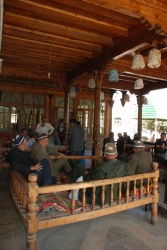 After perhaps over-bargaining for a shared taxi, we finally got on the road. Over-bargaining is when you get the price as low as it will probably go then waste time trying to get it lower. Or, eventually getting it a little lower but getting a bit screwed in the end. But who knows? Maybe if we paid the full price, the driver still wouldn't have taken us all the way. Anyway, the driver took us a little ways into Shakhristan and dropped us off at a bazaar which wasn't the central bazaar we had asked for. We started walking and realized we'd gone more than 300 meters without seeing a sign of Timurid architecture. When Rowshan asked we learned it was still a couple km away. So we caught a mashrutka to the center and once again were in business.
After perhaps over-bargaining for a shared taxi, we finally got on the road. Over-bargaining is when you get the price as low as it will probably go then waste time trying to get it lower. Or, eventually getting it a little lower but getting a bit screwed in the end. But who knows? Maybe if we paid the full price, the driver still wouldn't have taken us all the way. Anyway, the driver took us a little ways into Shakhristan and dropped us off at a bazaar which wasn't the central bazaar we had asked for. We started walking and realized we'd gone more than 300 meters without seeing a sign of Timurid architecture. When Rowshan asked we learned it was still a couple km away. So we caught a mashrutka to the center and once again were in business. I guess we are suffering from Timurid architecture overload. Another turquoise tile dome, more ornate tile-work on brick building, more highly decorated painted interiors. We glanced at the tombs, the iwan and area inside of Kok Gumbol--the mosque. The painting was comparatively unique since instead of being completely covered with designs, there were walls of rectangular panels with paintings inside. The tome paintings were also different. The courtyard/medressa was full of souvenir sellers.
We rushed past and went to the Khazrat Imam complex behind. It was a ruined brick building with some remains of a foundation. We glanced into a rather un-ornate tomb and a guy tried to sell us tickets. We decided he was probably a fake since his tickets weren't in a book (looked like the paper was too white (photocopied) instead of the usual ones printed on newsprint.) That and the site was supposed to be free. He was also annoying so we ignored him. Later we passed him again sitting at a souvenir table.
We walked back North through the town glancing at a caravansaray and mosques on the way. The Ak Saray (White Palace) isn't white and not much remains of the former huge complex. Upon the ruins, a large park complex has been built. The area had an atmosphere of a carnival. There was even a ferris wheel visible beyond the ruins! Around the park were cafes blasting music, crowds of tourists pouring back into tour buses and a couple wedding parties. A large statue of Timur dominates the center and serves as a backdrop for wedding photographs.
What remained of the palace was beautiful. It was the tall brick ruins of what perhaps had been an entrance tower. We didn't go up but we did admire the beautiful remains of the blue and white tile-work which covered some of the surfaces.Outside of the tower, we saw a group of musicians playing for a wedding party—long horns, a zurna type instrument, a nagara and another drum.
What remained of the palace was beautiful. It was the tall brick ruins of what perhaps had been an entrance tower. We didn't go up but we did admire the beautiful remains of the blue and white tile-work which covered some of the surfaces.Outside of the tower, we saw a group of musicians playing for a wedding party—long horns, a zurna type instrument, a nagara and another drum.
We decided to walk back to the center and get lunch at a very crowded chaihane. We ordered plov, tea and took a seat on a tea bed inside an enclosed wooden patio. The patio had ornate carved wooden pillars and ceilings. The plov was yummy and people working there were friendly. It was here we realized Shakhrisabz is more Uzbek than Tajik. Rowshan had to switch to Azeri instead of the Farsi he'd been using in Samarkand. On the main part of the patio which was completely open on the sides, the tea beds were full with mostly groups of men-- many older. Hanging from the ceiling were rows of covered bird cages. One of the men told Rowshan the birds were called budani and at 7PM the cages were uncovered and the birds woke up and sang (kind of like Disney's Tiki Room!). The man said he and his friends liked to relax by just sitting and watching the birds. Even without the birds, our lunch at the chaihane had revived us and made us feel happier about people. There is something very refined and gentlemanly about the chaihane. People casually talk and are friendly but you don't have to worry that they want anything from you besides conversation.
The area in front of the chaihane was also crowded. Men sat on platforms which had been placed on brick walls which housed trees. A couple men were playing chess. Rowshan got into a conversation with one of the spectators. Rowshan asked him if he played and the man replied, “only for money.” Rowshan joked, calling him Kasparov, “So you've already won everyone's money here.” The other men laughed. Another man told Rowshan he'd traveled to Iran and Konya (Turkey).
Next to the chaihane patrons, a group of Uzbek women in jewel colored velvets decorated with flowers and sparkles, wold jewelry from little portfolios they pulled out of their purses. We left with a good impression of Shakhrisabz, wishing there were more traditional chaihanes left in Uzbek cities.
Samarkand: Bibi Khanym, Guri Amir and a Note about Food
7 October, 2008, 04:44 am in "Uzbekistan"
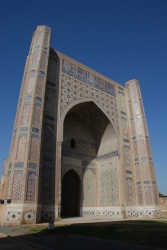 The Bibi Khanem Mosque has gone through some restoration on the exterior but the interior of the structure is mostly unrestored, falling into ruin. However, there is something rewarding about deciphering the faint remnants of patterns on the crumbling frescoed walls.
The Bibi Khanem Mosque has gone through some restoration on the exterior but the interior of the structure is mostly unrestored, falling into ruin. However, there is something rewarding about deciphering the faint remnants of patterns on the crumbling frescoed walls.The exterior tile-work, of course, wasn't as amazing as in the Registan but it was pretty with lines of flowers and snowflakes. The mosque in the interior had 2 interesting 5 sided pillars decorated with panels of tile work. In the center of the courtyard is a giant marble Koran stand surrounded by souvenir salespeople.
The Guri Amir Mausoleum's dome rises above the part of town between the Registan and the Russian part of town. It is turquoise and decorated with blue tile patterns. Inside the tomb room is decorated with blue and gold relief work and painted decoration in a Baroque like over abundance of decoration.
The tombstones are simple and serene-- blocks of carved marble and jade. The most exquisite is the carved light green jade stone of Muhammad Sulton (1374-1403). Amir Timur's tomb (1336-1405) is black. I couldn't tell if it was stone or ebony wood. The lower part of the mausoleum's interior is also decorated with beautiful carved jade and marble. The room echoes like a cathedral and is crowned by a crystal chandelier. The light from outside filters in through ornate grates.
In front of Guri Amir is the Rukhobod Mausoleum. There is an old medressa filled with souvenir shops. The mausoleum was built in 1380.
Uzbek Food in Samarkand
I should mention something about Uzbek food. Most of the restaurants/chaihanes have the standard Central Asian fare: laghman (noodles w/ meat), soup (with meat), shashlik (meat kebabs), manti (meat stuffed raviolis), plov (rice pilaf). So far we've had plov for lunch everyday we've been here but I don't mind because I like it. Here, (I don't know if this is seasonal) they make it with squash, onions, chickpeas, and sometimes raisins or peppers and just a few chunks of meat. It's a bit oily but tasty. We usually find it for lunch being made in big metal cauldrons over gas flames. It is prepared separately in the pot: rice, vegetables, and meat but served together. Usually people order a salad of tomatoes and cucumbers with it. On the street there are a lot of piroshki (fried dough stuffed with meat) and samsas (baked dough stuffed with meat) for sale. Here at the B&B, they serve a squash and onion samsa for breakfast every morning (except when there was no gas). For dinner, we usually buy a loaf of hot Samarkand bread, shiny with egg, heavy though small, with sprinkles of black sesame seeds. Rowshan has always been able to find a hot loaf. It is as if they are constantly baking them and they are bought up before they get cold. This we eat with cheese, tomatoes, and cucumbers (and NO MEAT!!!!).
It looks like the people of Samarkand have a sweet tooth. There are lots of cakes and cookies for sale. I also found fudge in some stores.
It looks like the people of Samarkand have a sweet tooth. There are lots of cakes and cookies for sale. I also found fudge in some stores.
Powered by My Blog 1.69. Copyright 2003-2006 FuzzyMonkey.net.
Created by the scripting wizards at FuzzyMonkey.net..
(Code modified by Rowshan Dowlatabadi)
Created by the scripting wizards at FuzzyMonkey.net..
(Code modified by Rowshan Dowlatabadi)


